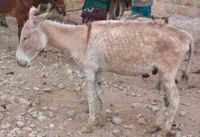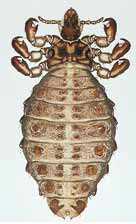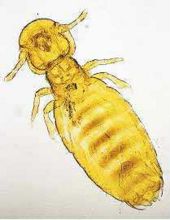Lice - Donkey
Introduction

Lice are common in groups of closely managed donkeys, but are less common in more extensive management systems. Both biting (Damalinia spp.) and sucking (Haematopinus spp.) lice occur in donkeys. Lice tend to be moderately species-specific and it is not clear if these are the same species that affect horses.
Signalment
Dense lice infestations are commonly observed during cooler periods, often covering most of the body. Young donkeys of less than three years of age and older donkeys in poor condition usually have the heaviest burdens.
Clinical signs


In both infestations pruritus may be seen and, although it may be mild, the donkey may develop a moth-eaten appearance without marked pruritus. Where pruritus is present it is usually worse in warm weather, and because lice infestations are most prevalent in late winter and early spring the coat alterations are usually obvious.
Infested donkeys have a dull dry coat with hair loss,scales and crusts. Adult lice and their eggs (nits) can normally be seen on the hair coat. The major dermatological problem seen in severe lice infestation among working donkeys is skin irritation, pruritus, often causing self-inflicted trauma, with extensive alopecia and concomitant excoriation. Animals infested with sucking lice may also be anaemic.
Secondary infections are common in the traumatised skin, but will usually involve opportunistic pathogens rather than severe skin pathogens. Scaling and flaking can develop if the infestation is prolonged, and selftrauma can result in a considerable exudative dermatosis with crusting.
Two syndromes occur following louse infestation:
Anaemia
Clinically significant anaemia may develop if severe infestations occur when Haematopinus asini is present.
- H. asini is the most common ectoparasite of the donkey
- Can infest donkeys in large numbers
- Completes its life cycle in three weeks
- Remains on the host for all stages of the life cycle
- Can cause general debility and weight loss if heavy infestations are not treated at an early stage
Pruritus
Caused by the biting louse Damalinia equi:
- Irritation may be severe, causing the donkey to bite and rub excessively
- The self-inflicted trauma to the skin may be followed by dermatitis, due to secondary bacterial infection
- Degree of irritation is not necessarily proportional to the number of parasites
- Donkeys may develop a hypersensitivity to lice and just a few lice may produce a severe reaction
A mixed infestation of both sucking and biting lice is most commonly seen in the donkey.
Diagnosis
Diagnosis can sometimes be more difficult than it seems. Skin brushings taken from large areas of the donkey into a Petri dish is the best approach (see chorioptic mange). A few cases have very few parasites and so skin scrapings and pluckings are of no real diagnostic value. It is important to remember that in-contact donkeys should be tested also (and treated if necessary).
Treatment
Lice can be difficult to treat effectively and control requires careful management of infected animals. It is better to treat all in-contact animals at the same time and to re-treat at 10- to 14-day intervals to ensure that re-emerging populations are eliminated at an early stage.
- Louse powders containing the synthetic pyrethroid permethrin or cypermethrin
- Pour-on anti-lice preparations containing 4% permethrin are very effective for treating the individual animal for both biting and sucking lice
- Instructions for persons applying pour-on preparations include wearing protective clothing, rubber gloves and boots. Read labels before using the products
- Sprays containing fipronil can be used.
- Parenteral ivermectin is also effective, particularly against blood sucking lice
- It has become common practice to use injections of ivermectin to control lice (and mites), but in D. Knottenbelt's opinion, this is not an effective method. There is no advantage in using the avermectins by injection as opposed to orally and the intravenous use carries significant dangers in horses and donkeys. Both ivermectin and doramectin have a beneficial effect for a limited period only, and this appears to be more due to the reduced activity of the lice rather than to any parasiticidal effects the drugs have.
- For animals showing allergic reactions to lice it is important to repeat treatment, including all in-contact equids, to eliminate all lice
Control
Survival of lice off the host is limited. Because lice are wingless and host specific, transfer between hosts primarily occurs by contact. The use of contaminated paddings, saddle blankets and other harnessing materials are an important means of transmission among working donkeys. Severely traumatised areas will need medical treatment.
Care must be taken not to re-infest the donkey due to poor management techniques. Grooming kit and tack should be cleaned and disinfected at the same time as the animals are treated, and any discarded hair carefully disposed of.
Literature Search
Use these links to find recent scientific publications via CAB Abstracts (log in required unless accessing from a subscribing organisation).
Lice in donkeys related publications
References
- Knottenbelt, D. (2008) Skin disorders In Svendsen, E.D., Duncan, J. and Hadrill, D. (2008) The Professional Handbook of the Donkey, 4th edition, Whittet Books, Chapter 8
- Trawford, A. and Getachew, M. (2008) Parasites In Svendsen, E.D., Duncan, J. and Hadrill, D. (2008) The Professional Handbook of the Donkey, 4th edition, Whittet Books, Chapter 6
|
|
This section was sponsored and content provided by THE DONKEY SANCTUARY |
|---|
